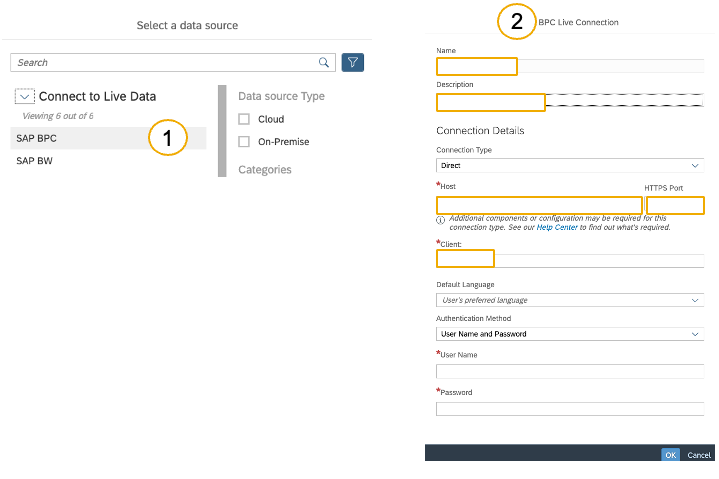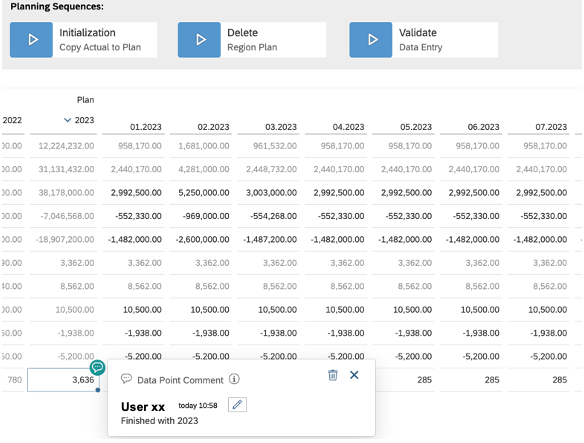
- SAP Community
- Products and Technology
- Technology
- Technology Blogs by SAP
- SAP BPC Move to SAC: Use SAP Analytics Cloud as da...
- Subscribe to RSS Feed
- Mark as New
- Mark as Read
- Bookmark
- Subscribe
- Printer Friendly Page
- Report Inappropriate Content

Introduction
The aim of this blog series is to explain the status of SAP Business Planning & Consolidation (SAP BPC) integration with SAP Analytics Cloud (SAC) and our strategic direction. Furthermore, we want to show you how SAP Analytics Cloud can extend and provide a positive ROI for your current planning, forecasting and analysis scenarios and help you run an Intelligent Enterprise. This is going to create new opportunities for planning, forecasting and analysis and thus it will help you steer your organisation even more effectively.
We also want to provide some guidance about the supported scenarios and high-level architectures and what can be done when it comes to modernising the existing planning & analysis solution of SAP BPC by adding SAC as:
- a unified user experience for:
- a planning (data entry) user interface,
- a data analysis interface,
- a planning extension,
- a pure SAC scenario (complete move from SAP BPC).
There will be several blog posts in the series that will cover relevant topics about integration and supported workflows, so please stay tuned for the updates of this blog post with all relevant links to additional blogs of the series:
- SAP BPC Move to SAC: Benefits & scenarios of moving SAP BPC planning scenarios to SAP Analytics Clou...
- SAP BPC Move to SAC: Use SAP Analytics Cloud as data entry UI for SAP BPC (THIS BLOG POST)
- SAP BPC Move to SAC: Work with BPC planning sequences in SAP Analytics Cloud
- SAP BPC Move to SAC: How to create a business workflow for BPC/BW live models with SAC Calendar
- SAP BPC Move to SAC: How to analyse data
- SAP BPC Move to SAC: MS Office/Excel add-in
- SAP BPC Move to SAC: Collaboration
We want to simplify our SAP Business Planning and Consolidation (BPC) customers’ transition journey to xP&A and to SAP Analytics Cloud (SAC) by allowing them to move at their own pace progressively, without disruption to their planning processes. To facilitate the MOVE of SAP BPC customers to SAP Analytics Cloud, we changed our commercial policy by introducing the BPC Runtime License and we provide technical solutions for tight integration and Live connectivity options with on-premise BPC applications.
In SAP Analytics Cloud you can integrate your BPC embedded planning models via the BPC Live-connection. This enables Live planning with your BPC models, the data updates (writeback) are made in real-time into the BPC embedded data providers, so there is no staging or duplication of data in SAC. Essentially you are leveraging the BPC embedded planning objects (data providers, input queries and business calculation functions) and only using SAC as a frontend user interface for planning and analysis.
In this current blog of the BPC MOVE blog series I want to illustrate how you can use the BPC Live-connection and consume the BPC embedded planning queries for building a data entry user interface in SAC.
In the next blog of our BPC MOVE blog series, I will be presenting how you can leverage the BPC embedded planning sequences for triggering remote BPC business logic and how to incorporate them into SAC stories and analytic applications for building an end-to-end BPC Live planning application in SAC.

Example: End-to-end BPC Live planning application in SAC
Prerequisites
Let’s start with the the prerequisite steps for enabling BPC Live planning with SAC:
- Via the BPC web client, create the BPC embedded Enviroment (1), create the BPC embedded Model (2) and assign your Composite Provider to all the BPC planning input queries (3). These will be your datasources for creating the SAC Live Planning Models.

Prerequisites: BPC Web Client configuration steps
- Afterwards estalish the BPC Live connection in SAC, by selecting the BPC Live connection type (1) and configuring the connection details (name, description, datasource host name, HTTPS port, client and user credentials) (2).

For more information about the BPC embedded Live data connection see the SAP Help.
How to
There is a simple BPC embedded planning example available in SAP BPC/BW systems, which follows a quantity-times-price approach for planning sales and contribution margin of vehicles across Europe, per Region and Product Category. See below the as-is vs to-be architecture, where currently SAP Analysis for Office is used as the frontend UI and will be replaced by SAC as a modernized unified UI for planning and analytics:

As-Is vs To-Be Architecture: BPC Live planning with SAC
As you can see from the picture above only the frontend user interface part will be replaced, all the BPC embedded objects like the providers (aDSO, composite, aggregation level), the BPC environment with the BPC model, the BPC planning query and the BPC planning sequences will be leveraged.
The first step will be to create the Planning Model by accessing Live data from BPC embedded in SAC, using the planning-enabled query of the BPC embedded application as a datasource. It is worth mentioning that all the queries built on the infoproviders of the selected BPC embedded model can be selected as datasources for creating the corresponding Live Planning Models in SAC.


SAC Model based on SAP BPC embedded Live connection
Now a few remarks about the created SAC Live Model. The dimensions and measures of the BPC planning query are listed in the SAC Model page. Only limited changes can be applied to the SAC Live Model, for example dimension descriptions can be changed, you can assign the version category to the version IDs and adjust measure decimal places.
Below is the list of the BPC features available with the BPC embedded Live planning in SAC.

BPC features: BPC embedded live planning with SAC
The BPC planning query used in our example for quantity and price data entry and sales and contribution margin calculations leverages the above BPC features. As you can see in the query configuration picture below the planning and computation logic is mainly built in the BPC planning query. With the Data Slice activation the actual version is locked. The Characteristic Relationships feature is used for enabling master data validation and derivation logic.

BPC planning query configuration
Finally the created SAC Live Model will be consumed in the SAC Story for planning the sales and contribution margin. The steps to create the SAC story are to add a canvas page and to select the table widget with the SAC Live Model as a Data Source. Additional configuration steps of table widget can be applied with the Builder Panel. For activating the data entry capabilities check the Planning Enabled setting, select the Data Entry Mode and set the Input Mode.

SAC Live Model consumption in SAC story
Upon data entry (e.g. changing the yearly plan sales quantity) the yearly figures will be disaggregated to periods and quantity-times-price calculations will take place up to the contribution margin level. Impacted data points will be highlighted in yellow and these changes will be stored in a temporaty technical version (planning buffer). They then have to be published for writing back the changes in realtime into the BPC data provider.


Publish data changes into BPC Live Model
The cell locking feature during data entry is also supported in the SAC table widget. Also, when working with SAC widgets on BPC queries you can create calculated measures, but only the three following options are supported: Calculated Measure, Restricted Measure, and Aggregation.

Finally, the SAP BW/BPC short-line comments functionality is available, thus comments are persisted into the BPC providers.

Regarding the data point commenting using Live-connected BPC/BW models on tables or with comment widget a dedicated blog will be published.

Summary
With BPC Live planning in SAC and the BPC Runtime License we satisfy customers requirements of all aspects:
- When corporate policy and regulatory requirements require on-premise situs of data storage, customers can utilize the hybrid planning with BPC embedded as a backend for data persistency and SAC as a modern unified user interface for planning and analytics.
- Avoid double licensing by using SAC and BPC embedded in parallel for planning use cases.
- Safeguard existing BPC on-premise planning investments.
- Extend existing BPC planning applications and combine them with other use cases in the cloud.
With this blog I provided all details of supported BPC features by using the BPC Live-connection for data entry in SAC. Stay tuned for next blog about triggering BPC embedded planning sequences (business logic) with Planning Trigger widget and how to incorporate them into SAC stories and analytic applications.
Check out the BPC MOVE blog series and this further information to learn more about the transition from SAP BPC to SAP Analytics Cloud:
- The SAP Note 2969947provides you the latest information of the supported and unsupported planning functionalities when using an SAC Model based on a BPC Live connection.
- Enabling BPC Runtime-license: https://launchpad.support.sap.com/#/notes/3150518
- Easily transition from BPC to SAC-P: https://www.sap.com/products/technology-platform/cloud-analytics/move-planning.html
- SAP Note 3308697 with SAP BPC Standard Migration guide
Ready to take the next step?
Start your cloud migration journey. Contact us at movebpc@sap.com to learn more about using SAP Analytics Cloud for Planning to migrate your SAP BPC investment to the Cloud and accelerate your business & financial transformation.
You must be a registered user to add a comment. If you've already registered, sign in. Otherwise, register and sign in.
-
ABAP CDS Views - CDC (Change Data Capture)
2 -
AI
1 -
Analyze Workload Data
1 -
BTP
1 -
Business and IT Integration
2 -
Business application stu
1 -
Business Technology Platform
1 -
Business Trends
1,658 -
Business Trends
95 -
CAP
1 -
cf
1 -
Cloud Foundry
1 -
Confluent
1 -
Customer COE Basics and Fundamentals
1 -
Customer COE Latest and Greatest
3 -
Customer Data Browser app
1 -
Data Analysis Tool
1 -
data migration
1 -
data transfer
1 -
Datasphere
2 -
Event Information
1,400 -
Event Information
67 -
Expert
1 -
Expert Insights
177 -
Expert Insights
311 -
General
1 -
Google cloud
1 -
Google Next'24
1 -
GraphQL
1 -
Kafka
1 -
Life at SAP
780 -
Life at SAP
13 -
Migrate your Data App
1 -
MTA
1 -
Network Performance Analysis
1 -
NodeJS
1 -
PDF
1 -
POC
1 -
Product Updates
4,576 -
Product Updates
353 -
Replication Flow
1 -
REST API
1 -
RisewithSAP
1 -
SAP BTP
1 -
SAP BTP Cloud Foundry
1 -
SAP Cloud ALM
1 -
SAP Cloud Application Programming Model
1 -
SAP Datasphere
2 -
SAP S4HANA Cloud
1 -
SAP S4HANA Migration Cockpit
1 -
Technology Updates
6,873 -
Technology Updates
442 -
Workload Fluctuations
1
- Adapt Clean Core Principle using SAP Cloud ALM in Technology Blogs by Members
- Experience the new Product Maintenance reporting in SAP for Me / Customer Insights dashboard in Technology Blogs by SAP
- Elevate Your SAP Cloud ALM Experience: Introducing the New ‘’Launchpad’’ and ‘’Welcome App’’ in Technology Blogs by SAP
- SAP BTP Innobytes – April 2024 in Technology Blogs by SAP
- SAP Analytics Cloud - Flatten hierarchy into columns in Technology Q&A
| User | Count |
|---|---|
| 19 | |
| 15 | |
| 12 | |
| 11 | |
| 9 | |
| 8 | |
| 8 | |
| 8 | |
| 7 | |
| 7 |